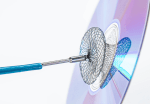Original title: Multicenter Evaluation of a Next-Generation Balloon-Expandable Transcatheter Aortic Valve. Reference: John Webb, et al. J Am Coll Cardiol 2014;64:2235-43 Percutaneous aortic valve replacement is starting to be a reasonable alternative in patients at intermediate risk. One hundred and fifty patients who received SAPIEN 3rd generation percutaneous aortic valve implantation were analyzed prospectively. The STS score of...
Percutaneous mitral valve treatment is a valid alternative in the long term
Original title: 4-Year Results of a Randomized Controlled Trial of Percutaneous Repair Versus surgery for Mitral Regurgitation. Reference: Laura Mauri, et al. J Am Coll Cardiol 2013;62:317-28 Surgical treatment of mitral regurgitation (MR) is currently recommended by either valve replacement or valvuloplasty. Devices are being developed to address this disease giving the benefits of percutaneous treatments. The EVEREST...
Aortic Transfemoral Valve Replacement using Edwards SAPIEN and Edwards SAPIEN XT Prosthesis, Local Anesthesia.
Reference: Durand E. et al (JACC CV interventions 2012 in press)1 When percutaneous aortic valve replacement (AVR) first began the procedure required a large-bore sheath (22-24 F), being the most frequent surgical strategy when using general anesthesia. Continuous technological advances achieved the miniaturization of devices which allow the procedure to be performed with a much...
Transcatheter Myotomy for the Treatment of the Dynamic Obstruction of the Left Ventricular Outflow Tract
Septal reduction therapies are used to mitigate the symptoms caused by dynamic left ventricular outflow tract (LVOT) obstruction and the associated mitral regurgitation (MR) that can surge in hypertrophic cardiomyopathy (HCM). Alternative therapies to treat LVOT obstruction include surgical procedures, i.e. surgical myotomy or myomectomy, or alcohol and radiofrequency septal ablation (intracardiac, transthoracic and endocardial,...
MitraClip in Patients with COPD: a Valid Option
Chronic obstructive pulmonary disease (COPD) and cardiovascular disease are associated to hospitalization and mortality. When associated to severe mitral regurgitation, not only do these two conditions have poor evolution, but they also limit the possibility of surgical valve replacement, given its high risk. Edge-to-edge repair with MitraClip has been shown beneficial in a group of...
Live Cases, Edited Cases and Lunch Symposiums Sponsored by the Industry
The participation of the medical industry is, undoubtedly, one of the most appealing aspects of the SOLACI-SOCIME 2018 Congress. As usual, the most important companies in this industry have decided to take part in our event. Their contribution is most valuable, as it brings relevance and improves the quality of our scientific presentations. Organize your...
Aortic Stenosis Progression Evolution
Aortic stenosis is an increasingly common valvulopathy because people are living longer now. A present, the main treatment consists of surgical (SAVR) or transcatheter aortic valve replacement. (TAVR). One of the main challenges of this disease is its progression. The European guidelines recommend Doppler echocardiograms every 2 to 3 years for mild cases, mildly calcified,...
12-Month Evolution of Edge-to-Edge Repair with PASCAL
Mitral regurgitation (MR) is the most frequent valve disease. Mitral transcatheter edge-to-edge repair (M-TEER) has been shown beneficial in high or prohibitive risk patients in cases of degenerative and functional MR. The PASCAL device has been shown safe and effective by the CLASP II, but we still need further research in clinical “real world” environments. ...
Edge-to-Edge Repair in Cardiogenic Shock
The edge-to-edge approach with MitraClip has been established as a valid strategy for patients who experience severe symptomatic mitral regurgitation (MI) with high risk for surgery, currently with a IIa indication. MI complicated by cardiogenic shock, which results in a high risk for conventional valve surgery, is a particularly complex scenario. In such a case,...
Left Atrial Appendage Closure and Concomitant Transcatheter Intervention: Can We?
Several scientific societies support performing left atrial appendage occlusion (LAAO) as a stand-alone procedure, even though it is often associated to other cardiomyopathies requiring transcatheter intervention. Though still controversial, combining LAAO and any other cardiac intervention might reduce hospitalizations, as well as the need for additional punctures, anesthesia, red tape, a longer stay and higher...








